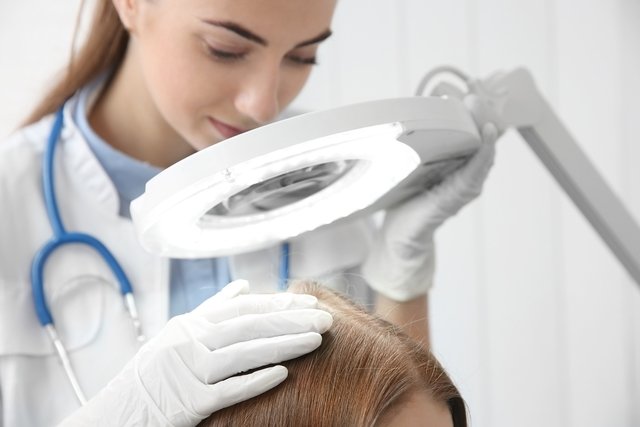Discoid lupus or discoid lupus erythematosus is a chronic inflammatory disease that affects the skin, causing symptoms such as round, red and scaly lesions, mainly noticed on the face and back of the neck.
These lesions arise due to changes in the immune system that acts against the body’s own healthy cells, resulting in skin inflammation and the development of symptoms. Learn more about lupus.
The treatment of discoid lupus is carried out by a dermatologist, who may recommend the use of corticosteroid or immunosuppressant ointments, in addition to care that must be followed on a daily basis, such as applying sunscreen daily.

Discoid lupus symptoms
The main symptoms of discoid lupus are:
- Red, round, plaque-shaped lesions;
- Formation of crusts in lesions;
- Peeling of the skin at the site of the injury;
- Increased skin sensitivity to the sun;
- Loss of hair or hair at the site of the injury, especially on the scalp.
Symptoms of discoid lupus usually appear mainly on the face, ears, neck and scalp, and can become more evident when the person is exposed to the sun.
In the presence of lesions possibly indicative of discoid lupus, it is important that a dermatologist is consulted so that a diagnosis can be made and appropriate treatment can be initiated.
How to confirm the diagnosis
The diagnosis of discoid lupus erythematosus is made by a dermatologist through evaluation of symptoms, health history and observation of skin lesions.
To confirm the diagnosis, the doctor may request an antinuclear antibody (ANA) test, however, as the autoimmune and inflammatory reaction is restricted to the skin, it is common for the result of this test to be negative or show a low titer.
Therefore, the doctor may recommend a biopsy of the lesion, in addition to a blood count and urine test to assess the presence of blood and proteins in the urine. See how a skin biopsy is performed.
If you want an evaluation by a dermatologist, schedule an appointment in the nearest region:
Taking care of your health has never been easier!
Possible causes
The causes of discoid lupus are not very well understood, however, it appears to be triggered by a combination of genetic and environmental factors that favor a more aggressive response by the immune system against the organism itself.
Some factors can increase the risk of developing discoid lupus, such as:
- Family history of discoid lupus;
- Exposure to UV radiation from the sun;
- Smoking habit;
- Stress, infections or trauma.
These factors can lead to the emergence of discoid lupus or trigger attacks, being more common in people aged 20 to 40, and in women.
What is the treatment like?
The treatment of discoid lupus must be carried out under the guidance of a dermatologist according to the characteristics of the lesions, and is mainly indicated:
- Sunscreen dailywith at least SPF 30, as the sun can worsen injuries or trigger flare-ups;
- Corticosteroid ointmentssuch as hydrocortisone;
- Injection of corticosteroids directly into the skin lesionas triancinolone acetonide;
- Immunosuppressive ointmentssuch as tacrolimus or pimecrolimus;
- Cremes retinoidessuch as tretinoin or tazarotene.
Furthermore, in cases where symptoms do not improve with treatment with creams or ointments, the doctor may recommend the use of antimalarial medications, such as hydroxychloroquine or chloroquine diphosphate.
Other medications that the doctor may also recommend are immunosuppressants, such as azathioprine, methotrexate, thalidomide or lenalidomide, for example.
The treatment of discoid lupus should always be carried out under the guidance of a dermatologist, on an individual basis, in addition to regular consultations to assess the response to treatment and the emergence of side effects.
Bibliography
- LU, Q.; et al. Guideline for the diagnosis, treatment and long-term management of cutaneous lupus erythematosus. J Autoimmun. 123. 102707, 2021
- MCDANIEL, B.; ET AL. IN: STATPEARLS (INTERNET). TREASURE ISLAND (FL): STATPEARLS PUBLISHING. Discoid Lupus Erythematosus. 2022. Available at: <https://www.ncbi.nlm.nih.gov/books/NBK493145/>. Accessed on May 9, 2023
- HEATH, C. R.; USATINE, R. P. Discoid Lupus. Skin. 109. 3; 172-173, 2022
- UDOMPANICH, S.; et al. Hair and Scalp Changes in Cutaneous and Systemic Lupus Erythematosus. Am J Clin Dermatol. 19. 5; 679-694, 2018
- MINISTRY OF HEALTH. Lupus: causes, symptoms, diagnosis, treatment and prevention. Available at: <https://antigo.saude.gov.br/saude-de-az/lupus>. Accessed on September 13, 2021
- AMERICAN OSTEOPATHIC COLLEGE OF DERMATOLOGY. Discoid lupus erythematosus. Available at: <https://www.aocd.org/page/DiscoidLupusErythe>. Accessed on September 13, 2021
- BRAZILIAN SOCIETY OF DERMATOLOGY. Lupus. Available at: <https://www.sbd.org.br/dermatologia/pele/doencas-e-problemas/lupus/32/>. Accessed on September 13, 2021

Sign up for our newsletter and stay up to date with exclusive news
that can transform your routine!
Warning: Undefined array key "title" in /home/storelat/public_html/wp-content/plugins/link-whisper-premium/templates/frontend/related-posts.php on line 12
Warning: Undefined array key "title_tag" in /home/storelat/public_html/wp-content/plugins/link-whisper-premium/templates/frontend/related-posts.php on line 13




